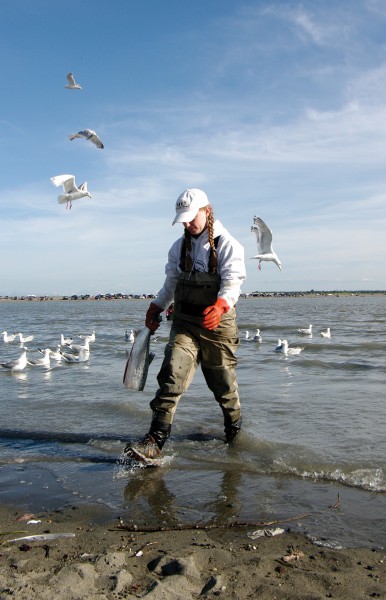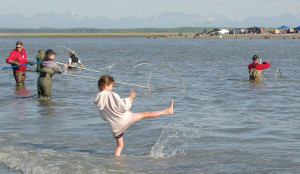
The late and hopefully-still-great run of sockeye might finally be making its way to the Kenai River.
The good news is that the bulk of the late run of Kenai River sockeye salmon might finally be making its appearance. The bad news is for the fishermen who tried to harvest them before this point in the run.
Baker: “I think I’m just gonna to head back tonight. I don’t know. If it was better I mighta stayed longer. It’s OK, but I’ll maybe try later.”
Mike Baker, of Anchorage, was sitting on the cooler he had hoped to fill at the north beach of the Kenai River on Monday evening, watching hundreds of his fellow dip-netters standing — and waiting — out in the water.
Baker: “It’s pretty slow, just kind of hit or miss. It’s just kind of waiting for people to pull fish in before I go back out.”
Fish counts underscore that assessment. The sockeye sonar counter in the Kenai River posted unimpressive numbers over the weekend — 17,500 fish Friday and 20,000 Saturday. The number jumped a bit Sunday to 49,000 fish, but that only brought the cumulative total of late-run Kenai River sockeye to just under 300,000 fish — not nearly as many as would have returned by this point in a more typical run, says Pat Shields, commercial fishery area management biologist for the Alaska Department of Fish and Game.
Shields: “It’s no secret to most people here that are dip-netters, that are in-river fishermen, that are commercial fishermen, that the Kenai sockeye run is late. We don’t know yet if they will return at forecast. We’re expecting about 3.5 million Kenai-bound sockeye to come back this year so it’s too early to say where we are with regard to how strong the run will be or how weak the run will be. But it’s most certainly going to be late.”
Managers are hopeful for the return, though. Other runs in Southcentral, including Chignik and Bristol Bay, are returning on a belated schedule but in good numbers. The same is expected for the Kenai.
Shields: “If we thought this run was on time or early there would be no more fishing for anybody. There would be no personal-use, no sport, no commercial. We would shut this thing down, we would lock it up and tell everybody to go home. We don’t believe that. We believe this run is late. So, yes, we’re watching it very closely.”
A positive sign came Monday at Fish and Game’s test fishery off Anchor Point. The test boat saw its biggest numbers yet on Monday. The catch is measured in index points representing catch per unit effort, which is later converted into an estimate of a passage rate to gauge how many sockeye have come by, and how many are likely still to arrive. Through July 19, the test nets had only logged 218 index points. By Monday afternoon, the test nets were on pace to get more than that in one day alone, with fish hitting all the sites stretched across the inlet.

Shields: “I don’t want to make too much out of one day of catch fish indices but it’s a very strong day. That’s a good sign. When you’re looking at a large index and you see it spread across all the stations, that’s a good indication that you have had fish come into the inlet.”
That’s what the dip-netters who were arriving Monday were hoping to hear, as opposed to the ones leaving after a mostly unproductive weekend.
Lynnette and Tim Blessie, of Eagle River, got to Kenai on Sunday but didn’t even bother getting their net down to the water until just about high tide Monday afternoon.
Tim Blessie: “It has been looking a little slow. We’ve heard that the run was slower getting here. We hope that doesn’t mean that there’s just not that many fish out there. We hope that it’s just because they’re late. But I haven’t seen them pulled out at the pace I have in past years.”

They shoot for fishing the Kenai around July 18 every year. But just because that’s when they schedule to come fish doesn’t mean that’s when the fish will arrive.
Blessie: “That’s why we stay a week.”
Timing, as always, is crucial in fishing. In this case, rather than having the luck of timing a fishing trip when the sockeye are flooding the river, logging time in the water seemed to be the difference between catching and just fishing at the Kenai dip-net fishery.
Patresha Burnell was celebrating her biggest day yet Monday, with nine fish hitting her net. She and her family had been at the mouth of the Kenai over the weekend.
Burnell: “Yesterday my brother had luck and my mom and my dad, now today’s my luck. I was out from 6 a.m. to 6 p.m. (yesterday) and I got a rock, but today I’m glad I’m catching my share.”
The sockeye sonar estimate for Monday showed continued improvement, at 53,600 fish, breaking the 350,000 mark in the run. That’s still 77,000 less than at this point in last year’s run, but over 4,400 fish more than any one day’s total so far this year.




